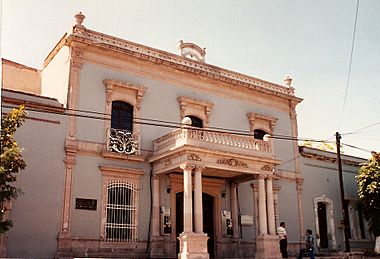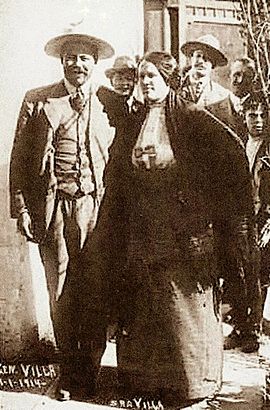Francisco Villa Museum facts for kids

The Francisco Villa Museum, also called the Historical Museum of the Mexican Revolution, is a special place in Chihuahua, Mexico. It teaches visitors all about the life of a famous Mexican leader, Francisco "Pancho" Villa, who was important during the Mexican Revolution. The museum is actually in the house where General Francisco Villa and his wife, María Luz Corral de Villa, used to live.
Contents
Exploring the Museum: What You'll See
The Francisco Villa Museum holds many interesting items from Villa's life and the Mexican Revolution. When Mrs. Villa passed away in 1981, she gave the house and all its collections to the Mexican government.
Inside the Museum: Special Items
- You can see the saddles Villa used. These were called McClellan saddles, known for being strong and fitting different horses.
- The museum also displays his pistols and shows his bedroom and living areas.
- There are many old photographs that show what Villa did during the Mexican Revolution.
- A very important item in the museum's courtyard is the car Villa was riding in when he died in 1923. It still has bullet holes!
- It is believed that Villa is buried in the Monumento a la Revolución in Mexico City.
The Story of the House: Quinta Luz
The house that became the museum was built between 1905 and 1907 in Chihuahua, Mexico. By 1911, it wasn't big enough for Villa's needs.
Remodeling the Home: A New Name
When Villa was the governor of Chihuahua in early 1914, he started making the house much bigger. He named it "Quinta Luz" to honor his wife, Señora doña Luz Corral. Many people helped with the remodeling, including Santo Vega, Hilario Berumen, Manuel Portillio, and an Italian painter named Mario Ferrer. The house was divided into three parts: the main house where Villa lived, a back house, and a courtyard.
Life After Villa: The Museum's Beginning
In 1915, the family had to leave the house for a while. After five years, Villa's wife, Luz Corral, returned to Mexico because she missed her home. Villa followed her. He passed away in 1923.
Near the end of her life, Luz Corral was very old and sick. In 1981, she decided that when she died, the house should become a museum to honor Villa. The Ministry of Defense agreed to her wish. Mrs. Villa passed away on July 6, 1981, at 89 years old.

Because the house was in poor condition, the National Institute of Anthropology and History had to do a lot of restoration work. The museum finally opened its doors on November 17, 1982. Villa's personal items, photographs, and the car he was in when he died are all on display.
What You Can See: Museum Exhibits
The museum has many interesting exhibits spread across two floors.
First Floor: Daily Life
On the first floor, you can see everyday items and furniture that the Villa Corral family used in their home.
Second Floor: History and Weapons
The second floor has five different rooms with special displays.
- Hall of Arms: This room shows the weapons Villa used in his battles. You can see revolvers, rifles, machine guns, and cavalry swords. There's also a photo of Rafael Mendoza, who invented an air-cooled machine gun during the Revolution.
- Tragic Room: This exhibit tells the story of General Villa's death. It includes a map of his last journey and a special mask made of his face shortly after he passed away.
- Throughout the museum, you will find many photographs that help tell the story of Villa's time.
Images for kids
-
Depiction of the Adelita, a famous corridos of the Mexican Revolution
See also
 In Spanish: Museo Histórico de la Revolución para niños
In Spanish: Museo Histórico de la Revolución para niños







